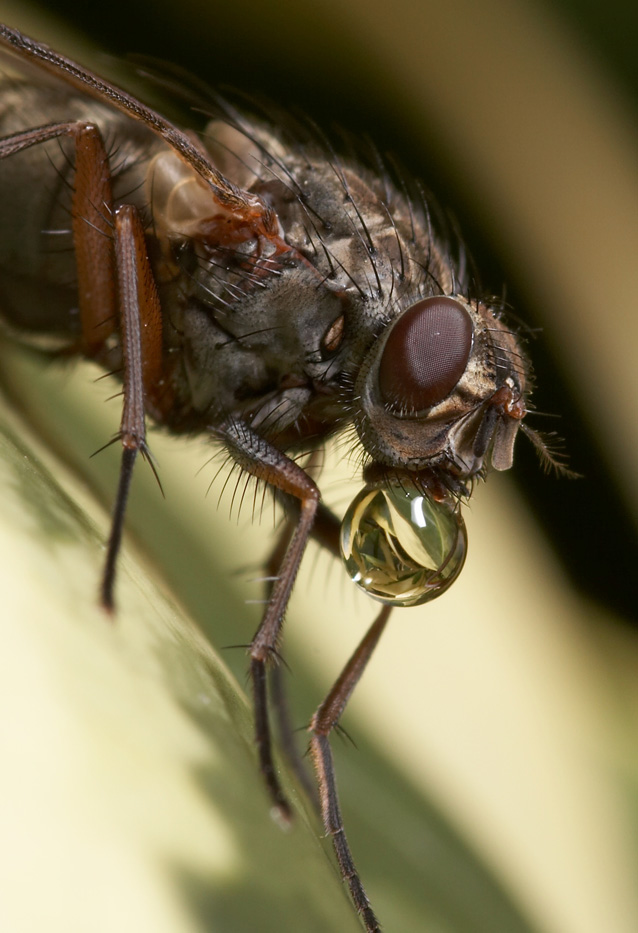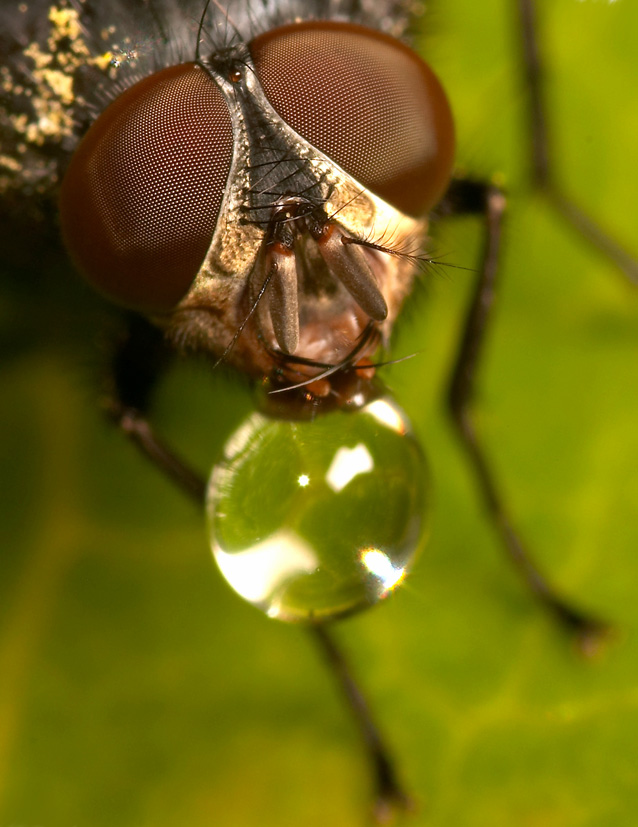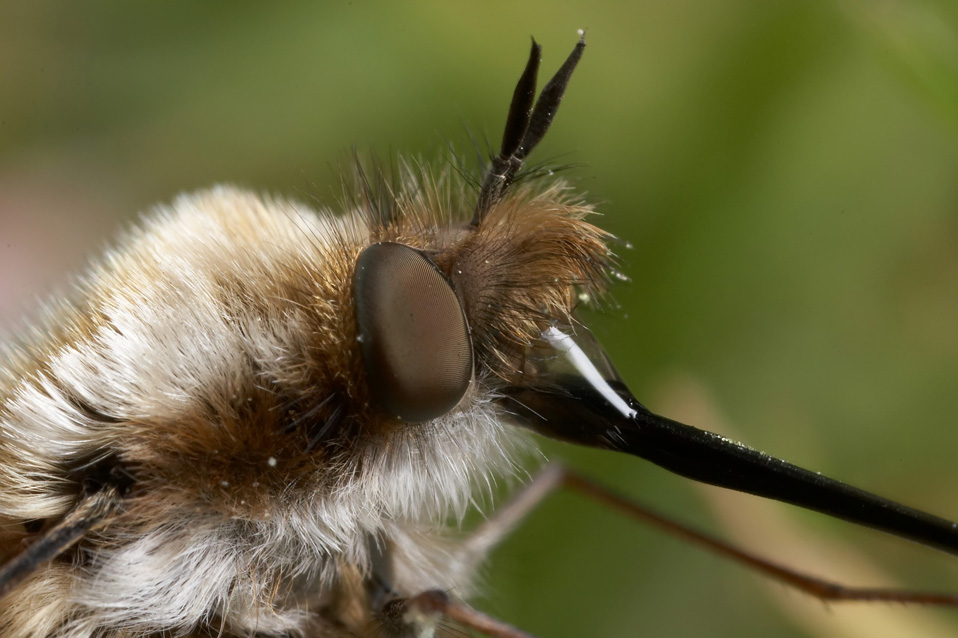Who is here? 1 guest(s)
|
Fly bubble blowing
|
|
| LordV |
Posted on 29-11-2005 15:39
|
|
Member Location: Posts: 671 Joined: 06.09.05 |
Well this one was in the sun today air temp 5'C - equivalent of smoking?
Edited by LordV on 29-11-2005 16:19 |
|
|
|
| lynkos |
Posted on 29-11-2005 20:07
|
|
Member Location: Posts: 466 Joined: 20.06.05 |
 Sarah Sarah |
|
|
|
| gardensafarinl |
Posted on 04-02-2006 18:38
|
|
Member Location: Posts: 79 Joined: 09.01.06 |
Dear Members, I am no expert on flies at all, but I do have pictures of a fly (don't know the species or genus) bubbling. It had been bubbling for quite some time, before we decided to make pictures of this behaviour. The pictures were taken on the 22nd of May from 12:54 to 12:59 and like I said the animal had been bubbling for some time already and at 13:00 it was still bubbling. The pictures were taken inside the house in a room with only one window, facing northwards. By the way: anyone any idea what fly this is? Cheers, Hans   |
|
|
|
| Dima DD |
Posted on 20-02-2006 00:32
|
|
Member Location: Posts: 75 Joined: 28.11.05 |
LordV wrote: New theory on this behaviour. ...Wonder if it's a way of warming up faster by letting the drop warm up in the sun and then sucking it back in again. Another reason for wondering this is normally flies seem to to sunbathe with their back to the sun (ie head away from the sun), whilst when they are bubble blowing they always seem to be facing the sun or at least at right angles to it, so the bubble is getting full sun. Brian V. I can not say which hypothesis is correct. However, I would like to put some words about this branch. In fact, body of the fly is darker and absorbs much more radiation than shining droplet. Moreover, evaporation of water from the surface must decrease droplet temperature, not warm it. More intensive evaporation - less the droplet temperature. Therefore, according to this branch of hypotheses ("thermoregulative"...), fly can use bubbling for cooling of its overheated body (i.e. it is some kind of "perspiration" ). Edited by Dima DD on 20-02-2006 18:21 |
|
|
|
| LordV |
Posted on 15-03-2006 18:20
|
|
Member Location: Posts: 671 Joined: 06.09.05 |
Tyhanks Dima. Having seen some more flies doing this especially one where the bubble got very viscous and almost looked semi solid, I've reached the conclusion that the thermoregulation hypothesis is wrong. It is much more likely that they are doing the same as bees do and actually concentrating the contents by evaporation. Brian V. |
|
|
|
| Kahis |
Posted on 15-03-2006 20:50
|
|
Member Location: Posts: 1999 Joined: 02.09.04 |
LordV wrote: Tyhanks Dima. Having seen some more flies doing this especially one where the bubble got very viscous and almost looked semi solid, I've reached the conclusion that the thermoregulation hypothesis is wrong. It is much more likely that they are doing the same as bees do and actually concentrating the contents by evaporation. Brian V. Hmm. I guess that is possible but it sounds like a terribly inefficient way of evaporating liquids. I'd guess absorbing water and allowing it to evaporate from the tracheal system (the lung equivalent) would be much faster. But perhaps insects have not invented this system yet  It's time for yet another hypothesis  The food is exposed to air leading to modifications in it's chemical composition by oxygenation. This would also radically change the microbial fauna of the liquid as most bacteria of the alimentary canal are anaerobic and will quickly perish when exposed to the terrible poison gas called oxygen The food is exposed to air leading to modifications in it's chemical composition by oxygenation. This would also radically change the microbial fauna of the liquid as most bacteria of the alimentary canal are anaerobic and will quickly perish when exposed to the terrible poison gas called oxygen
Kahis |
|
|
|
| conopid |
Posted on 17-03-2006 19:09
|
|
Member Location: Posts: 1039 Joined: 02.07.04 |
Just wanted to say that this is a great thread of discussion. I cannot add anything to the debate, but I will certainly be watching for bubble blowing flies in future!
Nigel Jones, Shrewsbury, United Kingdom |
|
|
|
| Xespok |
Posted on 17-03-2006 19:46
|
|
Member Location: Posts: 5550 Joined: 02.03.05 |
Kahis wrote: It's time for yet another hypothesis  The food is exposed to air leading to modifications in it's chemical composition by oxygenation. This would also radically change the microbial fauna of the liquid as most bacteria of the alimentary canal are anaerobic and will quickly perish when exposed to the terrible poison gas called oxygen The food is exposed to air leading to modifications in it's chemical composition by oxygenation. This would also radically change the microbial fauna of the liquid as most bacteria of the alimentary canal are anaerobic and will quickly perish when exposed to the terrible poison gas called oxygen A couple of remarks with this hypothesis: Why would flies need aerobic processes for what most other organisms mostly use anaerobic processes. The fundamental problem with the aerobicity is that, like us aerobic organisms degrade the carbon source to CO2, and this is no longer use to the fly. Anaerobic organisms degrade the carbon source to small monomers, part of which they ferment to low Carbon acids and alcohols which can be further utilized. I do not know how the digestion works in Arthropods, but I assume the same general principles apply that define the rules for us vertebratates. That is exactly why regions of our gastrointestinal tract that might be aerobic (down to the beginning of the small intestines) contain normally a low amount of natural flora. (bad luck if you have ulcer). Also the statement that anaerobic organisms quickly persih in aerobic conditons are very very far away from being true. In fact a very large fraction of the anaerobs show a hight degree of oxygen tolerance. Being aerob just means to be able to utilize oxygen as an electron acceptor while preserving energy. Being oxygen tolerant means that getting rid of oxygen costs extra energy. The resilience of the anerobic organisms of our gut to oxygen explains how these creatures travel from one individual to another, which inevitably involves spending time in aerobic niches. Edited by Xespok on 17-03-2006 19:46 |
|
|
|
| totipotent |
Posted on 21-03-2006 04:18
|
|
Member Location: Posts: 21 Joined: 10.02.06 |
LordV wrote: Ok just to shoot myself in the foot, spotted a Scatophaga stercoria bubble blowing this AM at an angle of about 120' from where the sun would have been if it was shining. Maybe it's the IR radiation that's important  . .Dima DD wrote: I can not say which hypothesis is correct. However, I would like to put some words about this branch. In fact, body of the fly is darker and absorbs much more radiation than shining droplet. Moreover, evaporation of water from the surface must decrease droplet temperature, not warm it. More intensive evaporation - less the droplet temperature. Therefore, according to this branch of hypotheses ("thermoregulative"...), fly can use bubbling for cooling of its overheated body (i.e. it is some kind of "perspiration" ). If we are considering the fly's position to the sun (or wind) then we must consider that the angle may be a way that the fly can attenuate the evaporative cooling or bubble warming (whichever floats your boat). Has anyone considered each fly's gender? LordV's image above only has the female (?) bubbling (=smoking)... ---------------------------------------------------------------------------------- This is my first post... |
|
|
|
| LordV |
Posted on 03-04-2006 21:04
|
|
Member Location: Posts: 671 Joined: 06.09.05 |
Sorry no new theories but I think the best shot I've managed yet of drop blowing- ever seen one with leaves in it? The leaves are actually a refracted image of the variagated holly bush the fly was sitting in- and no it's not photoshopped. Brian V. |
|
|
|
| Paul Beuk |
Posted on 04-04-2006 08:22
|
|
Super Administrator Location: Posts: 19208 Joined: 11.05.04 |
Excellent image!
Paul - - - - Paul Beuk on https://diptera.info |
|
|
|
| LordV |
Posted on 05-04-2006 07:38
|
|
Member Location: Posts: 671 Joined: 06.09.05 |
Thanks Paul.  Just as a thought does anyone know if fly regurgitant (is that a word?) has enzymes in it or is it microbe driven from the point of view of dissolving food stuffs? Just wondering if the original "aid to digestion" theory could be spot on if blowing bubbles helps concentrate (by evaporation) whatever helps to dissolve their food when they do regurgitate on it. Brian V. |
|
|
|
| T Bone |
Posted on 18-04-2006 06:49
|
|
Member Location: Posts: 8 Joined: 09.03.06 |
I was wondering: Could bubble-blowing be the symptom of a common fly illness--as sneezing and coughing and runny nose can be for a human cold? Or maybe it's a response to a common pesticide? One of the earlier post mentioned that flies, when blowing bubbles, remain more still and are easier to photograph. Is this a hindered flight response? (I'm not sure if I could run and have a coughing attack at the same time if I had to.) I know this post is rather after the fact, but . . . |
|
|
|
| Paul Beuk |
Posted on 18-04-2006 07:30
|
|
Super Administrator Location: Posts: 19208 Joined: 11.05.04 |
If the behaviour has something to do with digestion of food, flying off probably would mean the loss of the food that was being digested...
Paul - - - - Paul Beuk on https://diptera.info |
|
|
|
| Susan R Walter |
Posted on 29-04-2006 22:12
|
|
Member Location: Posts: 1794 Joined: 14.01.06 |
I watched a female Muscina sp blowing bubbles this morning. This is the first time I have witnessed this behaviour, but thanks to this forum, I immediately recognised what she was doing and stayed to watch. The droplets she produced were translucent blue grey (maybe only a reflection off her body). The droplet slowly grew to a couple of millimetres across then she slowly withdrew it, then the process was repeated. She was sitting in the sun, head to the east, on a bramble leaf. The droplet itself, because of the angle of the leaf, was not in the sun, but shaded by her body. I didn't have a camera with me, so no photo (and anyway, my photographic skills aren't good enough to add anything to these terrific images). I am also struck by something Totipotent touched on earlier - in this case, and in each of the pictures in this thread the bubbler is female. Susan |
|
|
|
| LordV |
Posted on 30-04-2006 18:27
|
|
Member Location: Posts: 671 Joined: 06.09.05 |
Susan R Walter wrote: I watched a female Muscina sp blowing bubbles this morning. This is the first time I have witnessed this behaviour, but thanks to this forum, I immediately recognised what she was doing and stayed to watch. The droplets she produced were translucent blue grey (maybe only a reflection off her body). The droplet slowly grew to a couple of millimetres across then she slowly withdrew it, then the process was repeated. She was sitting in the sun, head to the east, on a bramble leaf. The droplet itself, because of the angle of the leaf, was not in the sun, but shaded by her body. I didn't have a camera with me, so no photo (and anyway, my photographic skills aren't good enough to add anything to these terrific images). I am also struck by something Totipotent touched on earlier - in this case, and in each of the pictures in this thread the bubbler is female. Hate to burst anyones bubble but I think my all time champion biggest bubble blower is male (bubble is 2mm in diameter)  Brian V.  |
|
|
|
| Susan R Walter |
Posted on 02-05-2006 19:37
|
|
Member Location: Posts: 1794 Joined: 14.01.06 |
Brian A true Englishman just can't resist a pun  I didn't have a theory attached to the observation though, indeed I thought it seemed unlikely that bubble blowing was confined to females. Susan |
|
|
|
| Dmitry Gavryushin |
Posted on 13-05-2006 20:09
|
|
Member Location: Posts: 3303 Joined: 17.10.05 |
I guess that's the same thing with Scathophaga (image cropped). May 13, 2006. |
|
|
|
| LordV |
Posted on 15-05-2006 09:09
|
|
Member Location: Posts: 671 Joined: 06.09.05 |
Found a bee-fly bubble blowing- but did it at the near end of it's proboscis. It was very obviously giving its probe/tubes a good clean from the manipulations that were going on. Makes me wonder if the bubble blowing is a way of cleaning out the tubes in this and other flies? Brian V.  |
|
|
|
| pierred |
Posted on 18-05-2006 19:56
|
|
Member Location: Posts: 1413 Joined: 21.04.05 |
Hello, Here is my own one. It was on the shadow side of a rather big leaf and didn't move very much while bubbling. On the other hand, as soon as it had swallowed again the contents of this rather opaque bubble, it could not tolerate the flash of my camera anymore. Edited by pierred on 18-05-2006 19:57 Pierre Duhem |
|
|
|
| Jump to Forum: |













